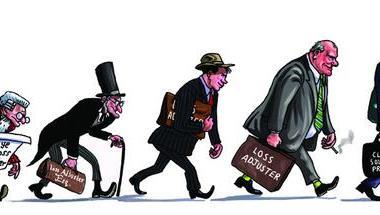After a successful MBO at Davies Group, Mark Chapman tells Sarah Kennedy how he plans to challenge the market leaders.
Following months of speculation, loss adjuster Davies completed a £27m management buy-out (MBO) earlier this month that toppled its partnership structure and fuelled the company’s goals for significant growth and modernisation.
In his first interview since becoming managing director of Davies, Mark Chapman says that due to the backing of private equity firm LDC, the company will now seek acquisition targets and organic growth opportunities to meet its goal of surpassing powerhouse Crawford as the second largest loss adjuster in the UK.
It’s difficult to imagine that something as potentially explosive as an MBO, resulting in the dissolution of a 39-year partnership, could come off smoothly without a clash of egos in the existing structure.
But Chapman says that is exactly what happened when key members of Davies decided that in order to grow and compete against market leaders Crawford & Co and Cunningham Lindsey, which have been pushing into new markets and investing heavily in technology, the business’s old-fashioned structure would have to be replaced.
There were real issues that confronted us,” says Chapman. “One was about succession. Some of the partners were getting older and there hadn’t been a lot of movement in senior management, and we wanted to freshen up the gene pool.
“The second issue was the funding of the business. All major developments were funded by the partners. It didn’t make sense in the modern world for a business like ours to be funded that way. There was concern that some of the guys were getting older and may be less eager to invest in an area that they would never see a return on.”
That scenario never played out, but Chapman says it was at the back of peoples’ minds and a potential obstruction to Davies’s development.
Although the old structure operated in a very amiable and successful way, it was at times speckled with confusion and not always clear who was responsible for what, he says. The company, for example, did not have a finance director, with most of those responsibilities falling into the lap of senior partner David Ede.
An MBO gives more clearly-defined roles to the former partners, many of whom had been with the company for over 30 years. And surprisingly there was no battling for the top spot.
Chapman, who joined the company in 1973 and rose to become deputy senior partner says it was always understood when Davies underwent the MBO, he would become managing director, while Ede, who led the company for 39 years, would step aside.
Partners Adrian Palmer, Les Wright and Darren Coombes have joined Chapman on the executive team. Two partners will leave the company and another two will remain as consultants. “There has been some reshuffling but we’ve maintained goodwill,” says Chapman. “This is all very exciting. It’s what I’ve always wanted.”
Chapman’s glee and energy over the new role is palpable. He is eager to take Davies through an ambitious growth plan, while maintaining the culture that its clients have come to respect.
“We will continue to be heavily focused on adjusting but we want to add on some more ancillary areas,” he says. “With this access to corporate funding we want to develop new products. Our investors are keen to see this business develop.”
The key focus for Chapman is growth. He says he wants to see the current turnover of £25m double over the next three years and to eventually replace Crawford and Company as the second largest loss adjuster in the country.
“All major developments were funded by the partners. It didn’t make sense for a business like ours to be funded that way.
Mark Chapman
He says: “The business will grow organically, but when opportunities present themselves, we will seek strategic acquisitions.”
Chapman says Davies will be looking to acquire other adjusters that can help the company gain strength in key areas. An MBO is a somewhat rare move in the loss adjusting market which has so far avoided the consolidation frenzy that seems to have captivated other areas of the insurance industry. With the exception of AMG’s acquisition of Carr Greenwood Smith and Sigma there has been little activity of adjusters buying adjusters.
“I don’t see massive amounts of real consolidation starting to take place in the market, but we may see more joining-up of niche areas,” says Chapman.
But Davies is willing to become a sort of trail-blazer in that regard, if the opportunity and the price were right.
“In order to be a top player, we need to offer a broad range of services. Our goal is to become a much more prominent player in the market than we are today. I would be very disappointed if we weren’t double the size in the next three years.
He concludes: “This is a fantastic thing for this company, it really needed it.” IT will continue to be heavily focused on adjusting but we want to add on some more ancillary areas,” he said. “With this access to corporate funding we want to develop new products. Our investors are keen to see this business develop.”
The key focus for Chapman is growth. He said he wants to see the current turnover of £25m double over the next three years and to eventually replace Crawford as the second largest loss adjuster in the country.
He says: “The business will grow organically but when opportunities present themselves, we will seek strategic acquisitions.”
Chapman says Davies will be looking to acquire other adjusters that can help the company gain strength in key areas. It is a somewhat rare move in the loss adjusting market that has so far avoided the consolidation frenzy that has captivated other areas of the insurance industry. With the exception of AMG’s acquisition of Carr Greenwood Smith and Sigma there has been little activity of adjusters buying adjusters.
“I don’t see massive amounts of real consolidation starting to take place in the market but we may see more joining up of niche areas,” says Chapman.
But Davies is willing to become somewhat of a trail blazer in that regard, if the opportunity and the price are right.
“In order to be a top player, we need to offer a broad range of services. Our goal is to become a much more prominent player in the market than we are today. I would be very disappointed if we weren’t double the size in the next three years.
He concludes: “This is a fantastic thing for this company, it really needed it.”
Chapmans rise to power
Chapman joined Davies in March 1973 initially as a trainee. Within two years he was transferred to the London West operation where he stayed until the early 1980s.
During that time he qualified and managed the branch, and became a partner in the business.
He was then moved to the Reading office in a similar management role. Two years later he became manager of the Guildford branch before returning to London West.
Chapman was primarily involved with strategic development, operations and client relationship management.
Hosted by comedian and actor Tom Allen, 34 Gold, 23 Silver and 22 Bronze awards were handed out across an amazing 34 categories recognising brilliance and innovation right across the breadth of UK general insurance.










































